Top 10 Patterns from Smith Lake
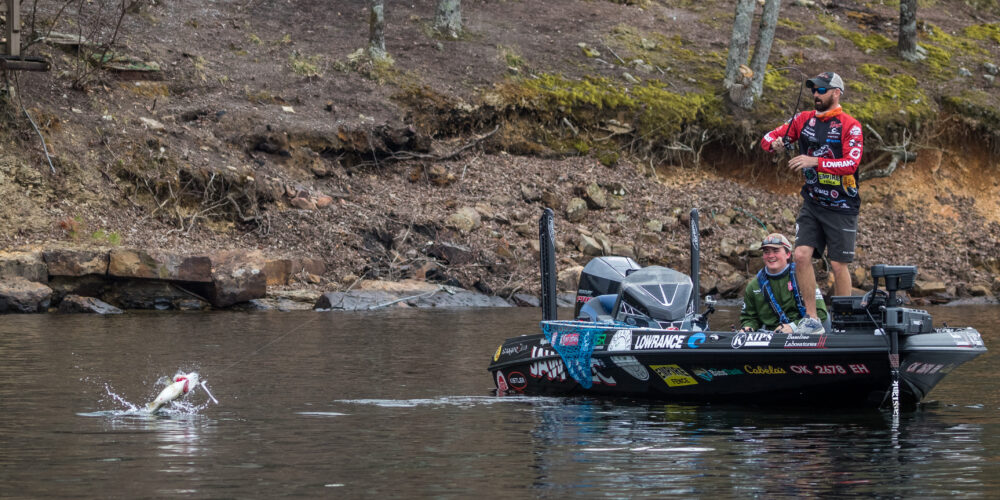
Keeping up with transitioning fish can be tough enough in the spring. And when that spring transition is condensed into a week? You have what happened at Lewis Smith.
The Tackle Warehouse Pro Circuit presented by Bad Boy Mowers saw pros practicing in winter coats and finishing in T-shirts – and the fishing changed just as dramatically.
Throughout the event, the story was often pros doing well one day only to bomb the next when they failed to adapt. That went for guys targeting spotted bass or largemouth, as neither species separated themselves as the key winner. Then again, John Cox managed to stay the most consistent of them all targeting shallow largemouth.
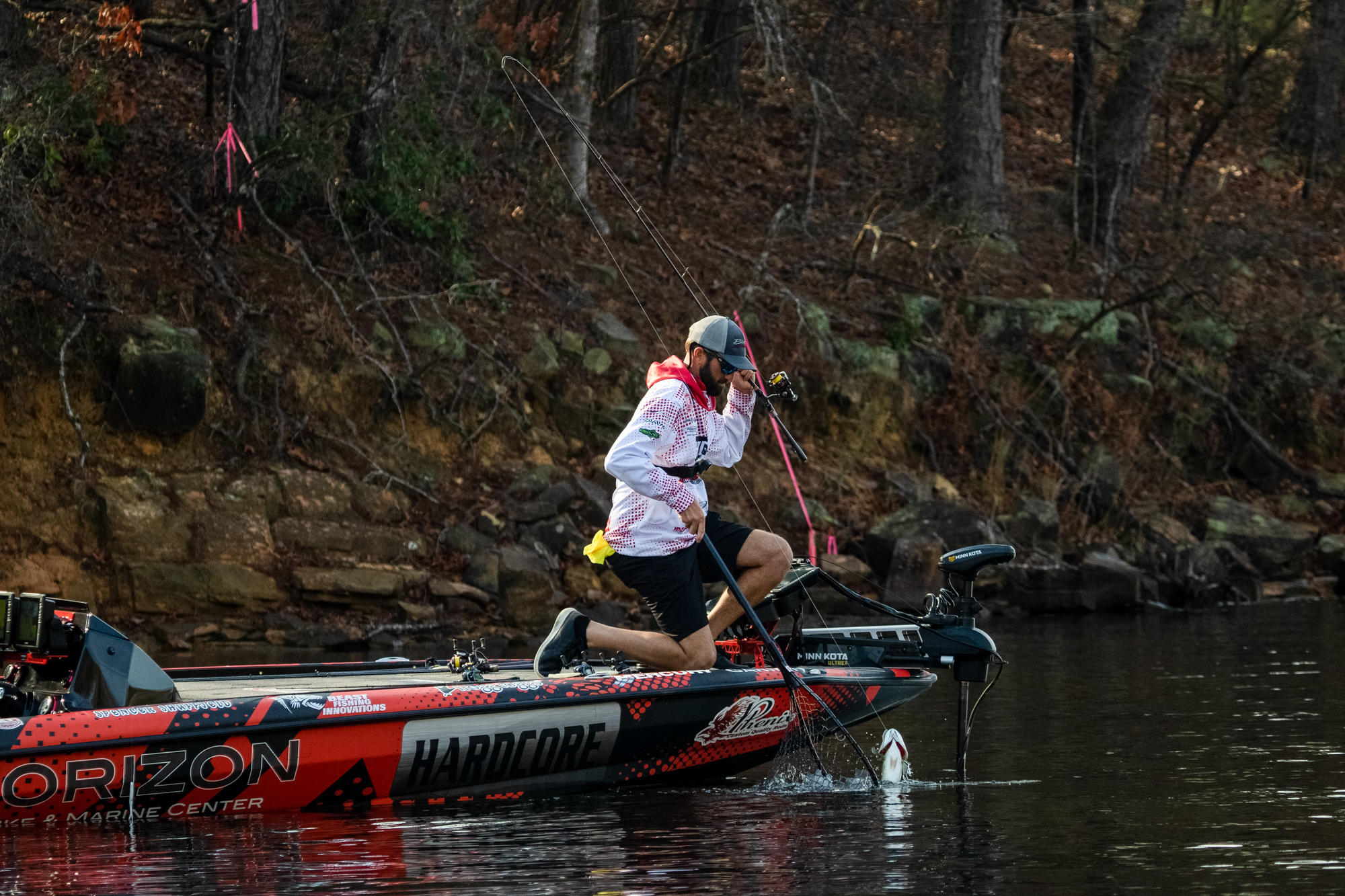
2. Day 2 Sidetrack Trips Up Shuffield
Almost every pro has adopted forward-facing sonar. None may be better at it than Spencer Shuffield.
The Hot Springs, Arkansas pro has dedicated himself to the technology, and it’s paid off big time for him in the last year. All that’s been missing to prove his prowess is a win. He nearly had it at the 2020 Tackle Warehouse TITLE until the weather doomed him the final day. At Lewis Smith, it was likely his performance on Day 2 that stopped him from winning.
“I was really getting dialed in on big ones when I saw a guy catching 3 ½ pounders every cast on Day 2,” Shuffield says. “I thought maybe I should be doing that, and I shouldn’t have. I wasted a lot of time doing that. When I went back to my pattern, I realized pretty quickly I should’ve stuck it out.”
No surprise, his pattern centered around Garmin Panoptix LiveScope and spotted bass, originally targeting them with Duel Hardcore Minnow Flat 95 and Yo-Zuri 3DB Series 110 (pearl shad) jerkbaits early in the tournament. That changed when he tried something a bit different.
“I picked up a Duel Hardcore Twitch’n Ninja Glider because I was seeing big fish up under the floats,” Shuffield says. “I wanted to see a reaction, and first cast, 10 big ones follow it out. I just had to figure out how to catch them off the sides of the docks.”
The ticket was his tried-and-true drop-shot and a small swimbait. The swimbait he’d skip up under the docks, but the drop-shot tipped with a Zoom Super Fluke Jr. he’d cast out along the sides and particularly the corners, swimming it back to the boat.
“Day 2 really cost me,” Shuffield says. “I gave it my all and left everything out there. It just wasn’t meant to be.”

3. Meyer Top 10s Again
Cody Meyer grew up fishing Lake Shasta, which seems like a random fact for a story about Alabama’s Lewis Smith. That is until you learn that Northern California’s Lake Shasta was stocked with spots from Smith Lake.
“They act the same, both at Shasta and [at Smith],” Meyer says. “The only difference is Shasta doesn’t have the herring, but the spots still roam around and act the same.”
With that in mind, it’s little surprise Meyer made yet another Top 10 on Smith. Though, he admits this one was a bit tougher than in years past.
“I had to change so much this event,” Meyer says. “I mean, every day was different. I fished just about everything there is to fish. I fished docks, pockets, bridges, over 100 feet of water, the face of the dam, laydowns – everything.”
Even his baits changed daily. On Day 1, he did his damage with an Evergreen FA 87 jerkbait, which he threw on a 6-9 Daiwa Tatula Elite rod, Daiwa Tatula SV reel and 10-pound-test Daiwa J-Fluoro Samurai fluorocarbon. By Day 2, he’d switched to a 3 ½-inch Yamamoto swimbait. And Day 3 is when he really started pulling out his bag of tricks, tossing the swimbait, a wacky-rigged Yamamoto Senko (baby bass) and even a popping cork with a homemade hair jig at the end.
“I just had to keep trying different things to even get them to bite,” says Meyer, who credits LiveScope for how he caught the majority of his fish, regardless of the location or presentation.

4. Cortiana Focuses on Isolated Docks, Water Temperature
A cold practice haunted many pros, but it actually was to Kyle Cortiana’s advantage when he realized he wasn’t getting bit up Rock Creek until the water temperature hit 57 degrees. Problem is, it wouldn’t get there until 3 p.m. in practice. But as things warmed up during the tournament, so did his fishing.
“Day 1, I didn’t have a keeper until noon,” the Oklahoma pro says. “Day 2, not until 10 a.m. Day 3, I had a limit before 10 a.m., and the final day the water started at 58 degrees and I caught them all day.”
Of course, it also helps to figure out a pattern to go with it, and Cortiana did that by keying on unique docks.
“They seemed to be holding to really deep bluff banks with isolated docks,” Cortiana says. “It’s like the fish had nothing else to relate to and were relating to docks with big cables. When herring would get up against them and I was there, it was game on, son. I was getting my arm ripped off.”
Using Lowrance ActiveTarget, Cortiana could tell when the docks set up right, especially when he saw “manatees” (aka. big fish) on his screen. And those big fish wanted big meals. Hence him throwing a Jawtec Baits Punch Shad swimbait on Kistler rods and reels.
“When I caught a big one, it would be coughing up herring 5-6 inches long,” Cortiana says. “So that’s what keyed me in to a little bit bigger bait.”

5. Hall Chases Down Roamers
Watching Kyle Hall fish this week was like watching someone who was lost.
Like most pros, he was using his LiveScope to target suspended spotted bass. The difference is, most pros were targeting them off structure. Not the 2020 Polaris Rookie of the Year.
“I was targeting suspended fish feeding on herring down near the dam out over open water,” Hall says. “It seemed like when I got around the bigger balls of bait I was going to find the bigger fish. So once I found the bait, I just roamed around looking for individual spotted bass suspended around them.”
Basically, Hall made circles over water anywhere from 20 to 100 feet just staring down until a fish popped up in which to make a cast. Typically, they were about 10 feet down and he was able to get them to bite with either a Strike King Rage Swimmer (electric shad) on a 3/8-ounce head or a Zoom Tiny Fluke, which he threw out weightless and let sink down to the fish. He threw both on Odiehammer rods and 12-pound test Seaguar fluorocarbon line.
Looking to make a big move on Day 3, he did attempt to go shallow and chase largemouth only to strikeout. That’s when he went back out deep and cracked 17 pounds, 3 ounces, which told him all he needed to know to do for the rest of the event.
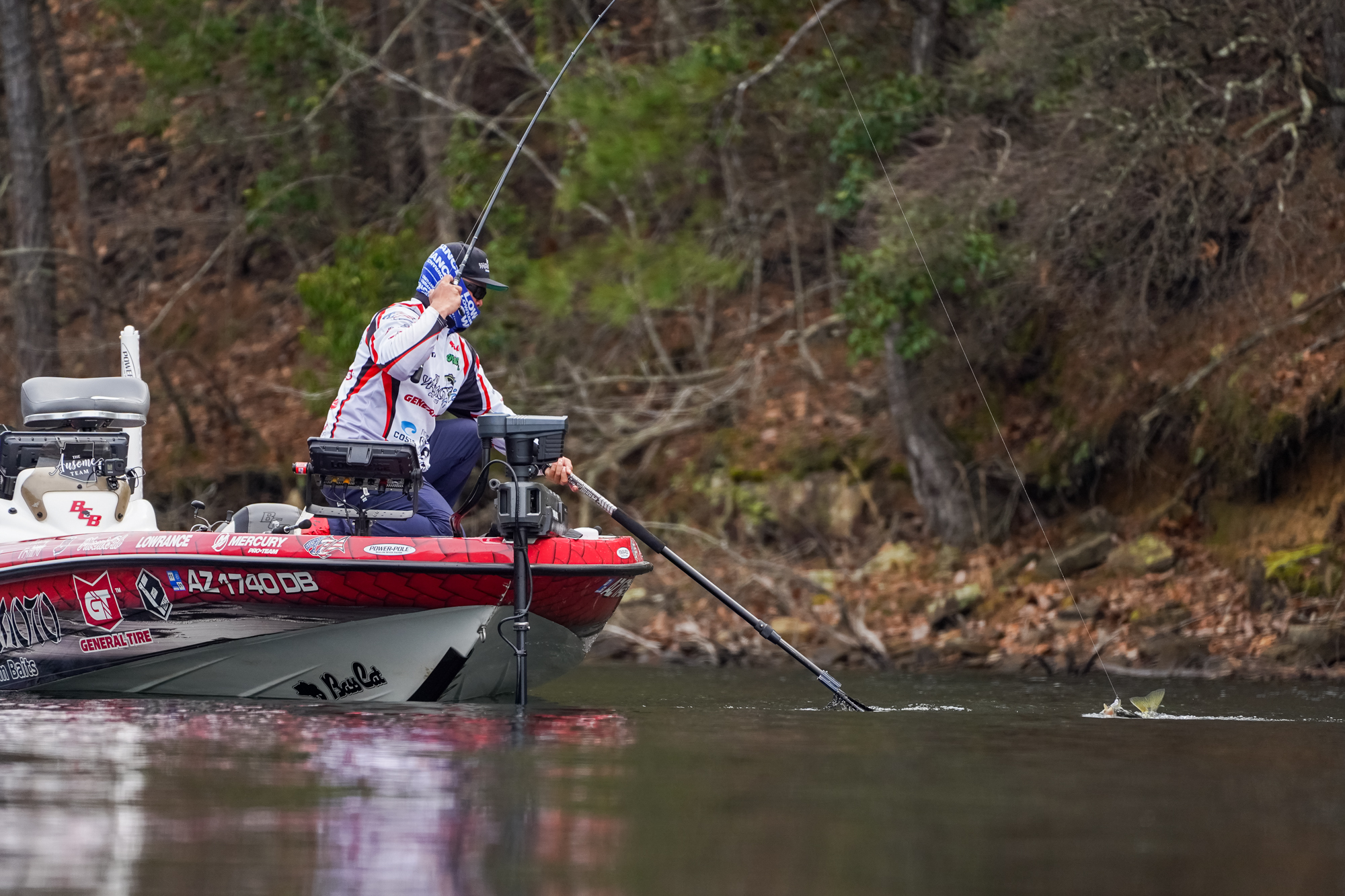
6. Au Goes Big with Goldilocks Pattern
Lewis Smith is a finesse angler’s dream. Don’t tell that to Tai Au.
The rookie who qualified after winning Strike King Angler of the Year in the Toyota Series presented by A.R.E. Western Division, Au has plenty of experience fishing for spotted bass on Lake Shasta. So he knows there are usually two ways to fish for them.
“At Shasta, you can play the deep game and catch tons of fish but they’re small,” Au says. “I’d rather go for quality over quantity. I don’t care how many I catch so long as I come in with five.”
And when the conditions lined up right, Au decided to go big by throwing a modified River2Sea S-Waver (crystal minnow). He threw the giant glide bait on a 7-6 Fitzgerald Heavy Okeechobee rod with a 7:1 gear-ratio reel spooled with 16-pound-test fluorocarbon line. To modify the S-Waver, Au removed the weights so it sank very slow, allowing him to fish it near the surface.
From there, it was just a matter of finding something just right.
“I was keying on points with clay, but they couldn’t be too deep or too shallow,” Au says. “I called it the Goldilocks pattern because it had to be just right with nearby deep-water access. The fish were suspending 30-50 yards offshore, and if I caught the right point at right time with bait pushed up, I’d catch one.”
Unfortunately, the boom-or-bust pattern began busting more and more as the event went on, as he missed a number of big fish that simply never got the hooks of his glide bait. By the end of the event, he had to switch up and rely on a wacky-rigged Yamamoto Senko to fill his limit, with a Duo Realis Pencil Topwater (crystal minnow) added in to catch a few schoolers.

7. No Redemption for Birge
Just thinking about his history on the lake angers him. Back in 2015, the then-rookie had a 5-pound lead going into the final day on Smith Lake only to stub his toe. He hasn’t forgotten.
Unfortunately, redemption for 2015 will have to wait a little longer for Zack Birge.
“It pisses me off just to think about it,” Birge says. “If I want redemption on any place, it’s here.”
Unfortunately, while he was trying to do the same thing he did back in 2015, he admits there weren’t near as many fish up shallow this year, which ultimately cost him. Still, that pattern of keying on the first couple docks going into creeks got him another Top 10. While fishing those shallow docks in Ryan Creek, his main tools were a wacky rig thrown on a 7-2 Favorite Jack Hammer rod, a Yo-Zuri 3DB Series 110 jerkbait (Table Rock shad) and a tiny swimbait thrown on a 7-3 Favorite Pro Series rod, with both spinning rods strung up with 15-pound test Yo-Zuri braid and 8-pound test Yo-Zuri fluorocarbon leaders.
As the tournament wore into Days 3 and 4, though, he also went to the backs of pockets to chunk and wind a buzzbait on a 7-3 Favorite Rush rod with 30-pound test Yo-Zuri braid. Unfortunately, as bad as he wanted that topwater action to work, it never really clicked and he scrapped it the final day to scrounge up a limit of spots to get as many points as he could to help him on the path to qualify for the TITLE.
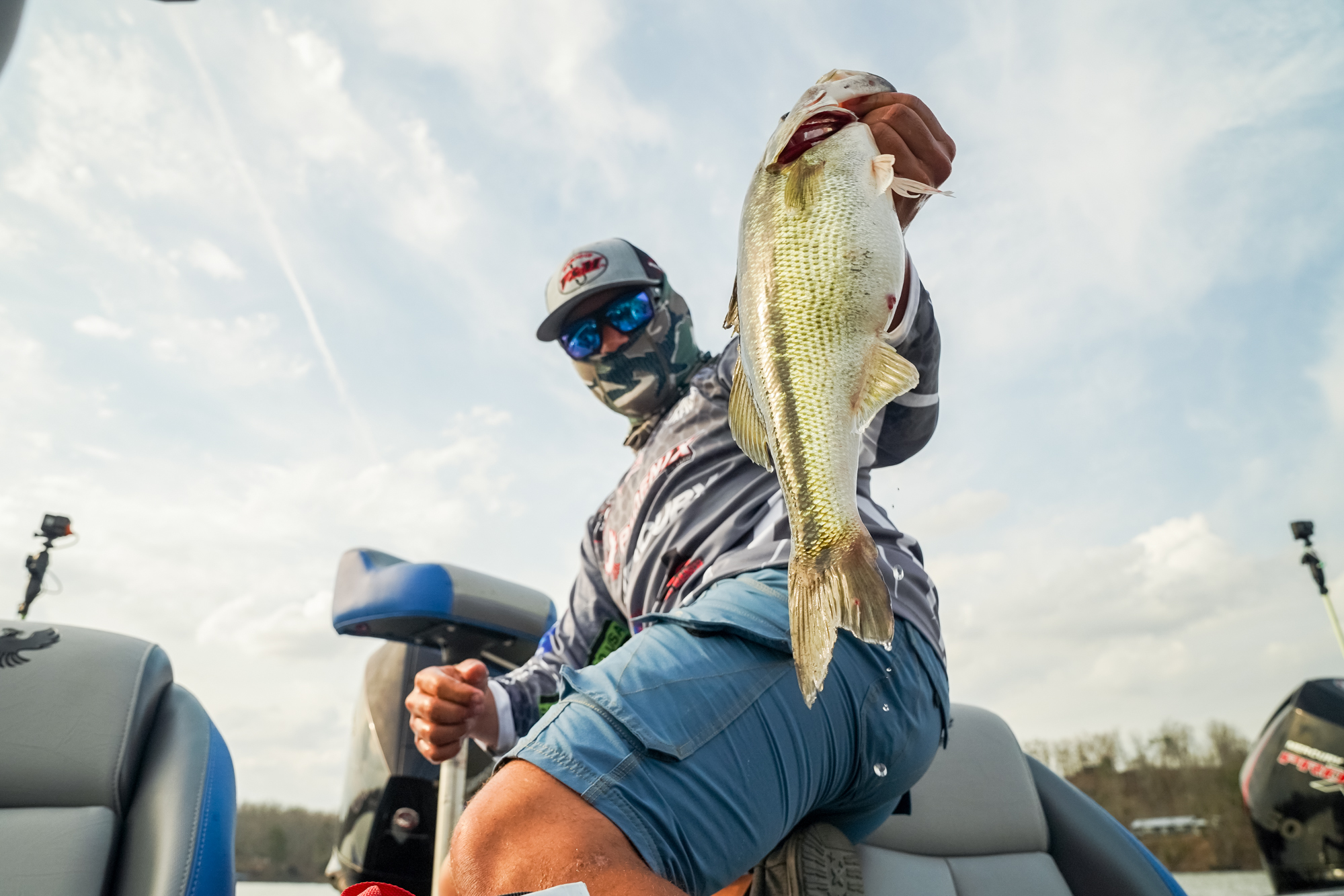
8. Cooper Gets First Taste of Spotted Bass, Top 10
Being a rookie means there’s quite the learning curve with learning different fisheries and techniques. In Justin Cooper’s case, that curve also meant figuring out a new species.
“This was my first time ever fishing for spotted bass,” says Cooper, who hails from Louisiana.
New species aside, he did know enough to look at main-lake points and bluff walls using LiveScope. And that was enough to key him in on a pattern.
“I was hitting 10-12 spots and rotating them between the Sipsey River and Rock Creek,” Cooper says. “The key was if there is a big boulder out off that bluff wall that I could see with my Livescope.”
If he found that and bait, he employed one of two MHX rods on his deck, which were both rigged with two different colors of V&M Wild Shads (French pearl and rainbow shad) on ¼-ounce Owner Ultrahead Round Jig Heads. Both were tied on 8-pound test Sunline Super FC Sniper fluorocarbon.
One thing he did notice, though, was that as the tournament went on, the fish got smarter.
“I think they’re getting smarter by the day with LiveScope,” Cooper says. “By the end of the tournament, I was having to make really long casts to them. I really think they feel that LiveScope.”
He also mixed in a Black Label Balsa Ricochet crankbait (junior size) while trying to target shallow largemouth.
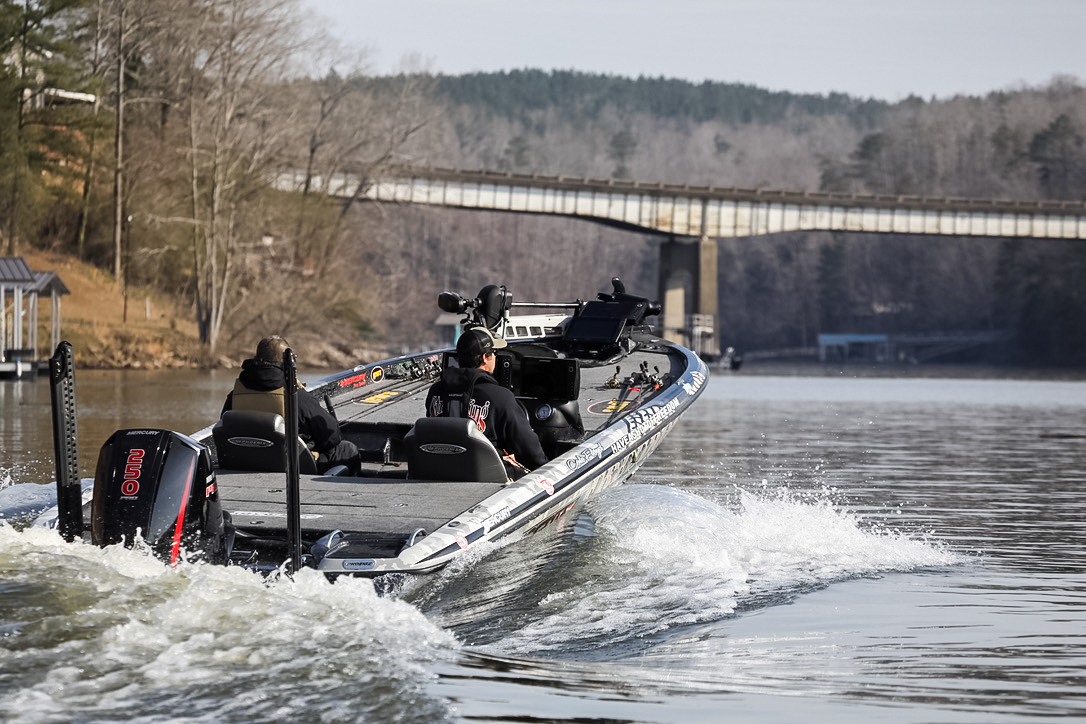
9. Floyd Scrambles Across Smith
If there was a mileage bonus, Cole Floyd would’ve earned it this week.
At any given time throughout the event, he could be found far up Lick Creek off Ryan Creek, way up Rock Creek and past the Duncan Bridge, up the Sipsey River. Sometimes, he hit all of them on the same day.
The goal was simple: target largemouth, which he did well at the beginning of the event. But come Day 3, the spotted bass seemed to take over his areas, particularly a stretch of bank up Rock Creek that accounted for more than 15 keepers.
“I don’t even know why they were there,” Floyd says of the key Rock Creek stretch. “It was kind of stair-stepped stuff, but my crankbait was not even touching bottom. So I don’t know if there was a shelf under there or what, but it kept reloading.”
A Strike King HC 2.5 squarebill (fire tiger) thrown on a Lew’s Team Custom Pro Mark Rose Ledge crankbait rod was his bread and butter up there. He also flipped trash mats there and heavy cover in the backs of the other creeks with a Strike King Rage Bug (green pumpkin) on a Hayabusa FPP Straight HD hook.

10. Morrow Goes Deep in New Area
Every time Troy Morrow comes to Smith Lake, he heads toward Rock Creek after leaving takeoff at the dam. He didn’t figure that would change, even with takeoff this time being far up Ryan Creek. Yet, apparently, it did.
“I kept trying to make it out of [Ryan] but I never did,” Morrow says. “I didn’t reset the fuel gauge, and it still says I have gas from Day 1.”
An electronics master, Morrow was among the suspended, spotted bass crew, using his LiveScope to seek out balls of bait.
“There really was no area,” Morrow says. “I was just roaming around looking for something not getting run over by boat traffic.”
Sometimes that bait was over 100 feet, sometimes shallower. The key was that Morrow learned to tell the difference between a bait ball of blueback herring or threadfin shad, and when he got in an area with bluebacks, he spent more time there.
In practice and early on in the event, Morrow threw a SPRO McStick and a couple other jerkbaits, switching from brighter colors to more natural as the week went on. Then a wakebait got mixed in and a couple swimbaits. By the end, he was throwing a Zoom Super Fluke (disco violet). All were thrown on Duckett Fishing rods and reels.
Unfortunately, the bass got extra finicky on him the final day, and despite many bites, he only hooked up with two.